HNN301 - Mental Health Promotion: Benzodiazepine Addiction Case Study
VerifiedAdded on 2023/06/07
|14
|3875
|455
Report
AI Summary
This report addresses the issue of prescription drug addiction, specifically focusing on benzodiazepines and their misuse. It highlights the role of nurses in mental health promotion, risk factors associated with addiction, potential complications, and protective measures to prevent drug abuse, especially among teens. The report also mentions programs like Strengthening Families for the Future (SFF) and Investing in Families (IIF), outlining their objectives and goals in improving family well-being and reducing health disparities. The case scenario of 'Tom' is used to illustrate how stress can lead to Benzodiazepine addiction, emphasizing the need for effective intervention and support programs. Desklib provides similar solved assignments and past papers for students.

1
Running head: MENTAL HEALTH PROMOTION
Mental Health Promotion
Student’s Name
Institutional Affiliation
Running head: MENTAL HEALTH PROMOTION
Mental Health Promotion
Student’s Name
Institutional Affiliation
Paraphrase This Document
Need a fresh take? Get an instant paraphrase of this document with our AI Paraphraser
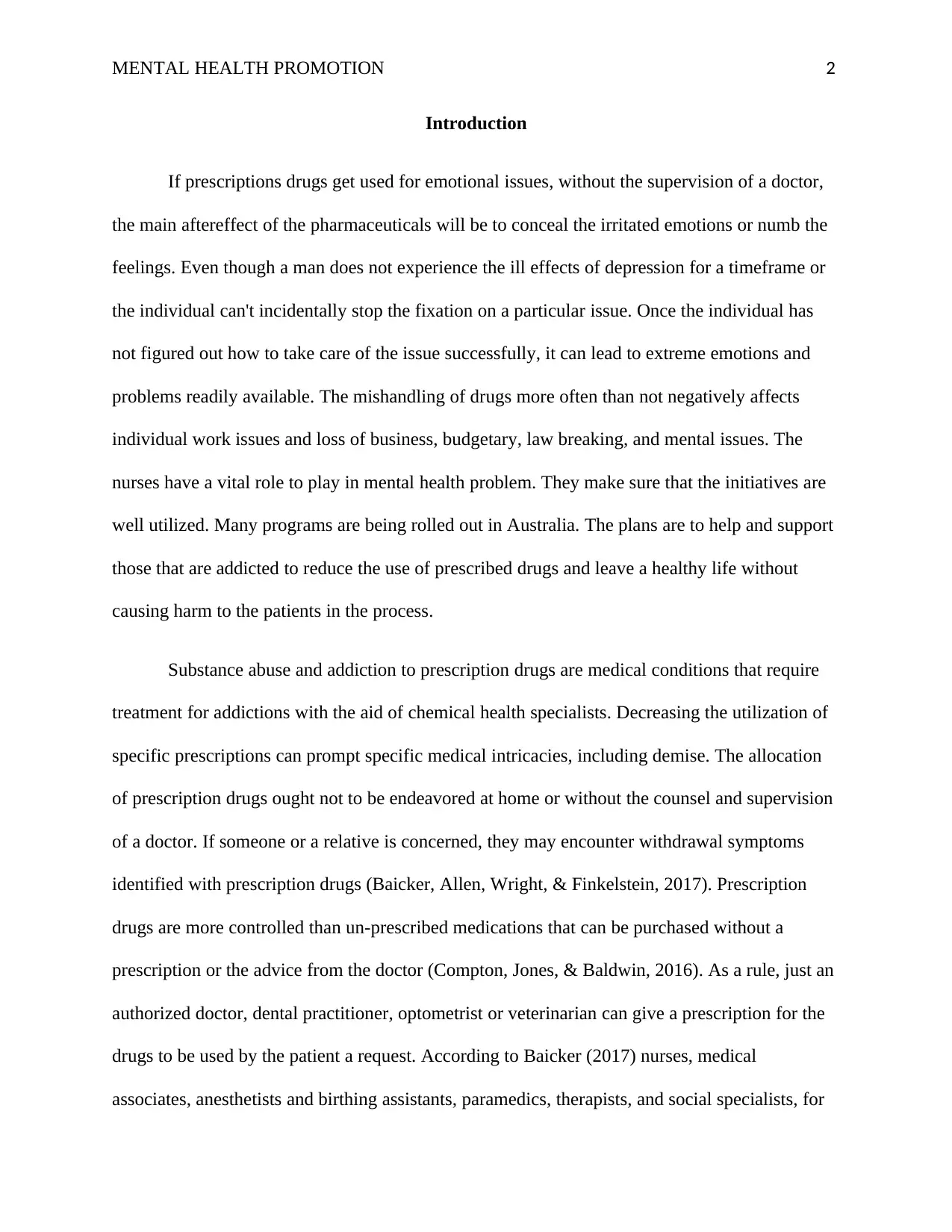
MENTAL HEALTH PROMOTION 2
Introduction
If prescriptions drugs get used for emotional issues, without the supervision of a doctor,
the main aftereffect of the pharmaceuticals will be to conceal the irritated emotions or numb the
feelings. Even though a man does not experience the ill effects of depression for a timeframe or
the individual can't incidentally stop the fixation on a particular issue. Once the individual has
not figured out how to take care of the issue successfully, it can lead to extreme emotions and
problems readily available. The mishandling of drugs more often than not negatively affects
individual work issues and loss of business, budgetary, law breaking, and mental issues. The
nurses have a vital role to play in mental health problem. They make sure that the initiatives are
well utilized. Many programs are being rolled out in Australia. The plans are to help and support
those that are addicted to reduce the use of prescribed drugs and leave a healthy life without
causing harm to the patients in the process.
Substance abuse and addiction to prescription drugs are medical conditions that require
treatment for addictions with the aid of chemical health specialists. Decreasing the utilization of
specific prescriptions can prompt specific medical intricacies, including demise. The allocation
of prescription drugs ought not to be endeavored at home or without the counsel and supervision
of a doctor. If someone or a relative is concerned, they may encounter withdrawal symptoms
identified with prescription drugs (Baicker, Allen, Wright, & Finkelstein, 2017). Prescription
drugs are more controlled than un-prescribed medications that can be purchased without a
prescription or the advice from the doctor (Compton, Jones, & Baldwin, 2016). As a rule, just an
authorized doctor, dental practitioner, optometrist or veterinarian can give a prescription for the
drugs to be used by the patient a request. According to Baicker (2017) nurses, medical
associates, anesthetists and birthing assistants, paramedics, therapists, and social specialists, for
Introduction
If prescriptions drugs get used for emotional issues, without the supervision of a doctor,
the main aftereffect of the pharmaceuticals will be to conceal the irritated emotions or numb the
feelings. Even though a man does not experience the ill effects of depression for a timeframe or
the individual can't incidentally stop the fixation on a particular issue. Once the individual has
not figured out how to take care of the issue successfully, it can lead to extreme emotions and
problems readily available. The mishandling of drugs more often than not negatively affects
individual work issues and loss of business, budgetary, law breaking, and mental issues. The
nurses have a vital role to play in mental health problem. They make sure that the initiatives are
well utilized. Many programs are being rolled out in Australia. The plans are to help and support
those that are addicted to reduce the use of prescribed drugs and leave a healthy life without
causing harm to the patients in the process.
Substance abuse and addiction to prescription drugs are medical conditions that require
treatment for addictions with the aid of chemical health specialists. Decreasing the utilization of
specific prescriptions can prompt specific medical intricacies, including demise. The allocation
of prescription drugs ought not to be endeavored at home or without the counsel and supervision
of a doctor. If someone or a relative is concerned, they may encounter withdrawal symptoms
identified with prescription drugs (Baicker, Allen, Wright, & Finkelstein, 2017). Prescription
drugs are more controlled than un-prescribed medications that can be purchased without a
prescription or the advice from the doctor (Compton, Jones, & Baldwin, 2016). As a rule, just an
authorized doctor, dental practitioner, optometrist or veterinarian can give a prescription for the
drugs to be used by the patient a request. According to Baicker (2017) nurses, medical
associates, anesthetists and birthing assistants, paramedics, therapists, and social specialists, for
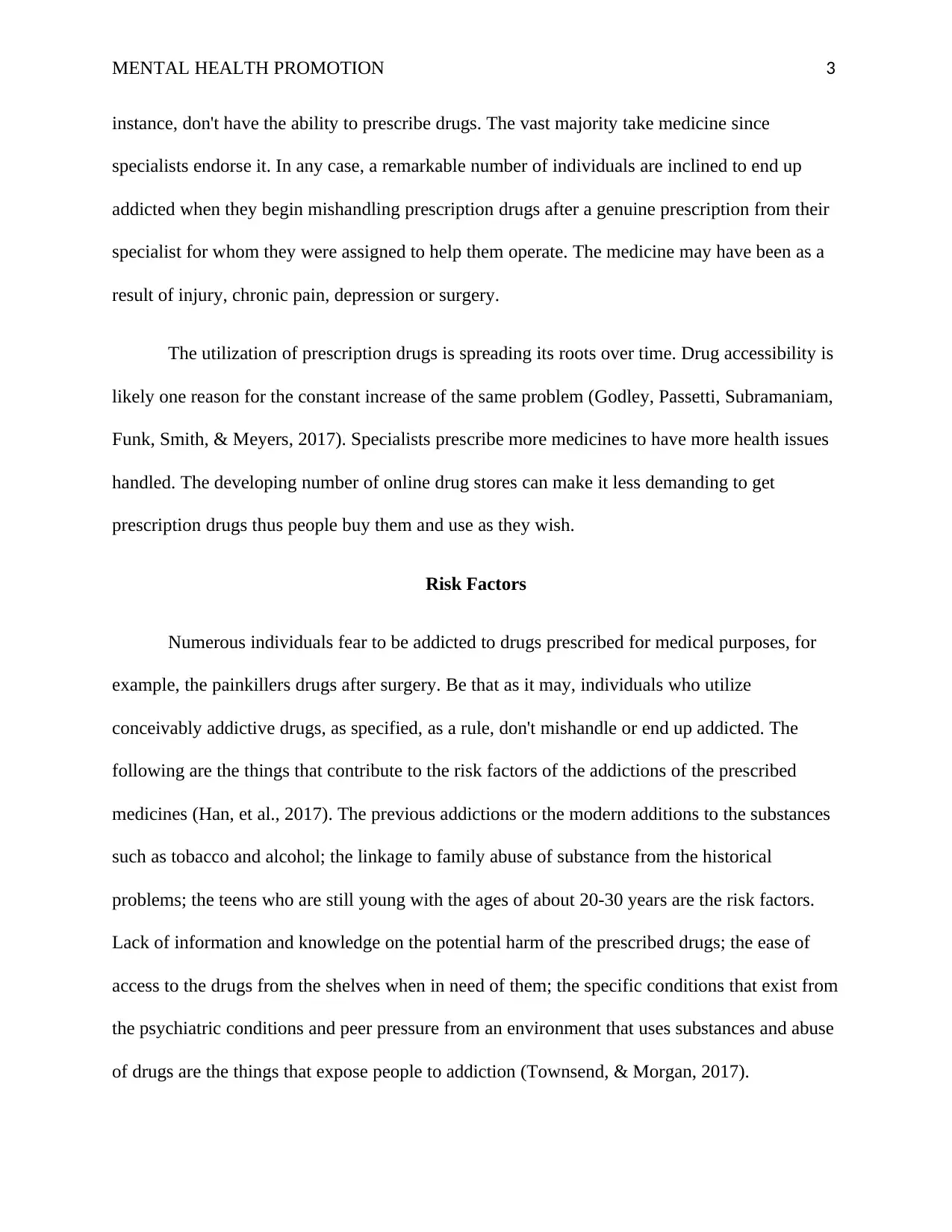
MENTAL HEALTH PROMOTION 3
instance, don't have the ability to prescribe drugs. The vast majority take medicine since
specialists endorse it. In any case, a remarkable number of individuals are inclined to end up
addicted when they begin mishandling prescription drugs after a genuine prescription from their
specialist for whom they were assigned to help them operate. The medicine may have been as a
result of injury, chronic pain, depression or surgery.
The utilization of prescription drugs is spreading its roots over time. Drug accessibility is
likely one reason for the constant increase of the same problem (Godley, Passetti, Subramaniam,
Funk, Smith, & Meyers, 2017). Specialists prescribe more medicines to have more health issues
handled. The developing number of online drug stores can make it less demanding to get
prescription drugs thus people buy them and use as they wish.
Risk Factors
Numerous individuals fear to be addicted to drugs prescribed for medical purposes, for
example, the painkillers drugs after surgery. Be that as it may, individuals who utilize
conceivably addictive drugs, as specified, as a rule, don't mishandle or end up addicted. The
following are the things that contribute to the risk factors of the addictions of the prescribed
medicines (Han, et al., 2017). The previous addictions or the modern additions to the substances
such as tobacco and alcohol; the linkage to family abuse of substance from the historical
problems; the teens who are still young with the ages of about 20-30 years are the risk factors.
Lack of information and knowledge on the potential harm of the prescribed drugs; the ease of
access to the drugs from the shelves when in need of them; the specific conditions that exist from
the psychiatric conditions and peer pressure from an environment that uses substances and abuse
of drugs are the things that expose people to addiction (Townsend, & Morgan, 2017).
instance, don't have the ability to prescribe drugs. The vast majority take medicine since
specialists endorse it. In any case, a remarkable number of individuals are inclined to end up
addicted when they begin mishandling prescription drugs after a genuine prescription from their
specialist for whom they were assigned to help them operate. The medicine may have been as a
result of injury, chronic pain, depression or surgery.
The utilization of prescription drugs is spreading its roots over time. Drug accessibility is
likely one reason for the constant increase of the same problem (Godley, Passetti, Subramaniam,
Funk, Smith, & Meyers, 2017). Specialists prescribe more medicines to have more health issues
handled. The developing number of online drug stores can make it less demanding to get
prescription drugs thus people buy them and use as they wish.
Risk Factors
Numerous individuals fear to be addicted to drugs prescribed for medical purposes, for
example, the painkillers drugs after surgery. Be that as it may, individuals who utilize
conceivably addictive drugs, as specified, as a rule, don't mishandle or end up addicted. The
following are the things that contribute to the risk factors of the addictions of the prescribed
medicines (Han, et al., 2017). The previous addictions or the modern additions to the substances
such as tobacco and alcohol; the linkage to family abuse of substance from the historical
problems; the teens who are still young with the ages of about 20-30 years are the risk factors.
Lack of information and knowledge on the potential harm of the prescribed drugs; the ease of
access to the drugs from the shelves when in need of them; the specific conditions that exist from
the psychiatric conditions and peer pressure from an environment that uses substances and abuse
of drugs are the things that expose people to addiction (Townsend, & Morgan, 2017).
⊘ This is a preview!⊘
Do you want full access?
Subscribe today to unlock all pages.

Trusted by 1+ million students worldwide
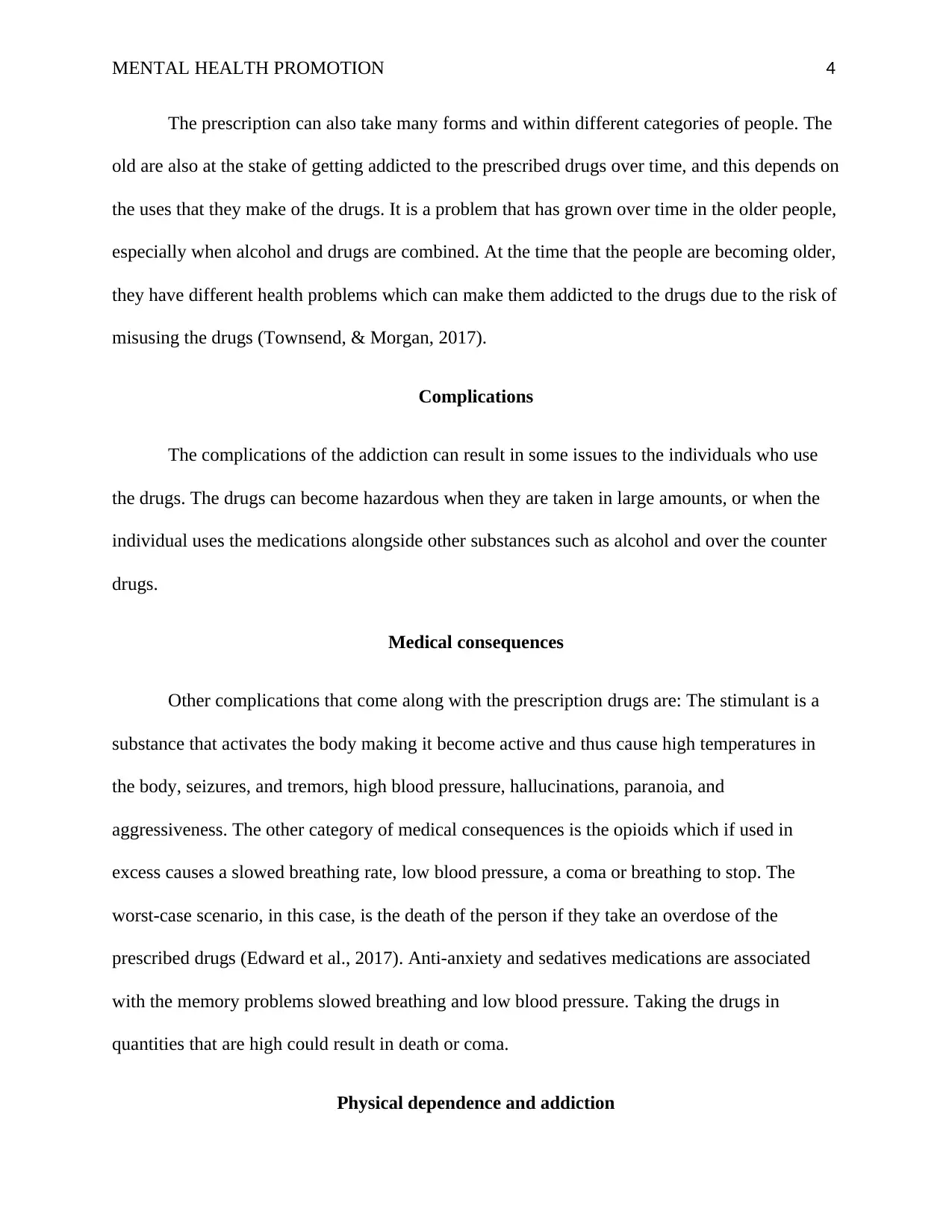
MENTAL HEALTH PROMOTION 4
The prescription can also take many forms and within different categories of people. The
old are also at the stake of getting addicted to the prescribed drugs over time, and this depends on
the uses that they make of the drugs. It is a problem that has grown over time in the older people,
especially when alcohol and drugs are combined. At the time that the people are becoming older,
they have different health problems which can make them addicted to the drugs due to the risk of
misusing the drugs (Townsend, & Morgan, 2017).
Complications
The complications of the addiction can result in some issues to the individuals who use
the drugs. The drugs can become hazardous when they are taken in large amounts, or when the
individual uses the medications alongside other substances such as alcohol and over the counter
drugs.
Medical consequences
Other complications that come along with the prescription drugs are: The stimulant is a
substance that activates the body making it become active and thus cause high temperatures in
the body, seizures, and tremors, high blood pressure, hallucinations, paranoia, and
aggressiveness. The other category of medical consequences is the opioids which if used in
excess causes a slowed breathing rate, low blood pressure, a coma or breathing to stop. The
worst-case scenario, in this case, is the death of the person if they take an overdose of the
prescribed drugs (Edward et al., 2017). Anti-anxiety and sedatives medications are associated
with the memory problems slowed breathing and low blood pressure. Taking the drugs in
quantities that are high could result in death or coma.
Physical dependence and addiction
The prescription can also take many forms and within different categories of people. The
old are also at the stake of getting addicted to the prescribed drugs over time, and this depends on
the uses that they make of the drugs. It is a problem that has grown over time in the older people,
especially when alcohol and drugs are combined. At the time that the people are becoming older,
they have different health problems which can make them addicted to the drugs due to the risk of
misusing the drugs (Townsend, & Morgan, 2017).
Complications
The complications of the addiction can result in some issues to the individuals who use
the drugs. The drugs can become hazardous when they are taken in large amounts, or when the
individual uses the medications alongside other substances such as alcohol and over the counter
drugs.
Medical consequences
Other complications that come along with the prescription drugs are: The stimulant is a
substance that activates the body making it become active and thus cause high temperatures in
the body, seizures, and tremors, high blood pressure, hallucinations, paranoia, and
aggressiveness. The other category of medical consequences is the opioids which if used in
excess causes a slowed breathing rate, low blood pressure, a coma or breathing to stop. The
worst-case scenario, in this case, is the death of the person if they take an overdose of the
prescribed drugs (Edward et al., 2017). Anti-anxiety and sedatives medications are associated
with the memory problems slowed breathing and low blood pressure. Taking the drugs in
quantities that are high could result in death or coma.
Physical dependence and addiction
Paraphrase This Document
Need a fresh take? Get an instant paraphrase of this document with our AI Paraphraser
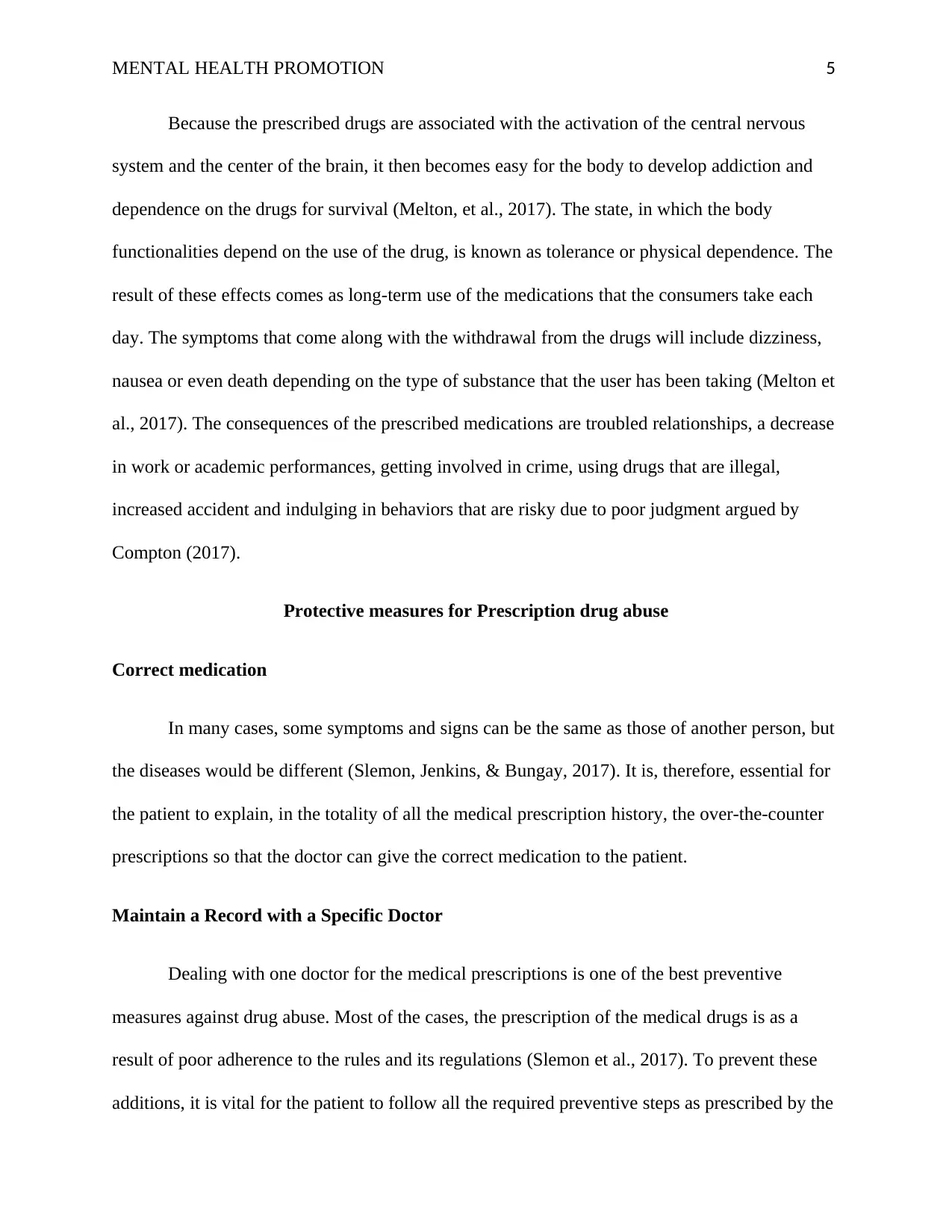
MENTAL HEALTH PROMOTION 5
Because the prescribed drugs are associated with the activation of the central nervous
system and the center of the brain, it then becomes easy for the body to develop addiction and
dependence on the drugs for survival (Melton, et al., 2017). The state, in which the body
functionalities depend on the use of the drug, is known as tolerance or physical dependence. The
result of these effects comes as long-term use of the medications that the consumers take each
day. The symptoms that come along with the withdrawal from the drugs will include dizziness,
nausea or even death depending on the type of substance that the user has been taking (Melton et
al., 2017). The consequences of the prescribed medications are troubled relationships, a decrease
in work or academic performances, getting involved in crime, using drugs that are illegal,
increased accident and indulging in behaviors that are risky due to poor judgment argued by
Compton (2017).
Protective measures for Prescription drug abuse
Correct medication
In many cases, some symptoms and signs can be the same as those of another person, but
the diseases would be different (Slemon, Jenkins, & Bungay, 2017). It is, therefore, essential for
the patient to explain, in the totality of all the medical prescription history, the over-the-counter
prescriptions so that the doctor can give the correct medication to the patient.
Maintain a Record with a Specific Doctor
Dealing with one doctor for the medical prescriptions is one of the best preventive
measures against drug abuse. Most of the cases, the prescription of the medical drugs is as a
result of poor adherence to the rules and its regulations (Slemon et al., 2017). To prevent these
additions, it is vital for the patient to follow all the required preventive steps as prescribed by the
Because the prescribed drugs are associated with the activation of the central nervous
system and the center of the brain, it then becomes easy for the body to develop addiction and
dependence on the drugs for survival (Melton, et al., 2017). The state, in which the body
functionalities depend on the use of the drug, is known as tolerance or physical dependence. The
result of these effects comes as long-term use of the medications that the consumers take each
day. The symptoms that come along with the withdrawal from the drugs will include dizziness,
nausea or even death depending on the type of substance that the user has been taking (Melton et
al., 2017). The consequences of the prescribed medications are troubled relationships, a decrease
in work or academic performances, getting involved in crime, using drugs that are illegal,
increased accident and indulging in behaviors that are risky due to poor judgment argued by
Compton (2017).
Protective measures for Prescription drug abuse
Correct medication
In many cases, some symptoms and signs can be the same as those of another person, but
the diseases would be different (Slemon, Jenkins, & Bungay, 2017). It is, therefore, essential for
the patient to explain, in the totality of all the medical prescription history, the over-the-counter
prescriptions so that the doctor can give the correct medication to the patient.
Maintain a Record with a Specific Doctor
Dealing with one doctor for the medical prescriptions is one of the best preventive
measures against drug abuse. Most of the cases, the prescription of the medical drugs is as a
result of poor adherence to the rules and its regulations (Slemon et al., 2017). To prevent these
additions, it is vital for the patient to follow all the required preventive steps as prescribed by the
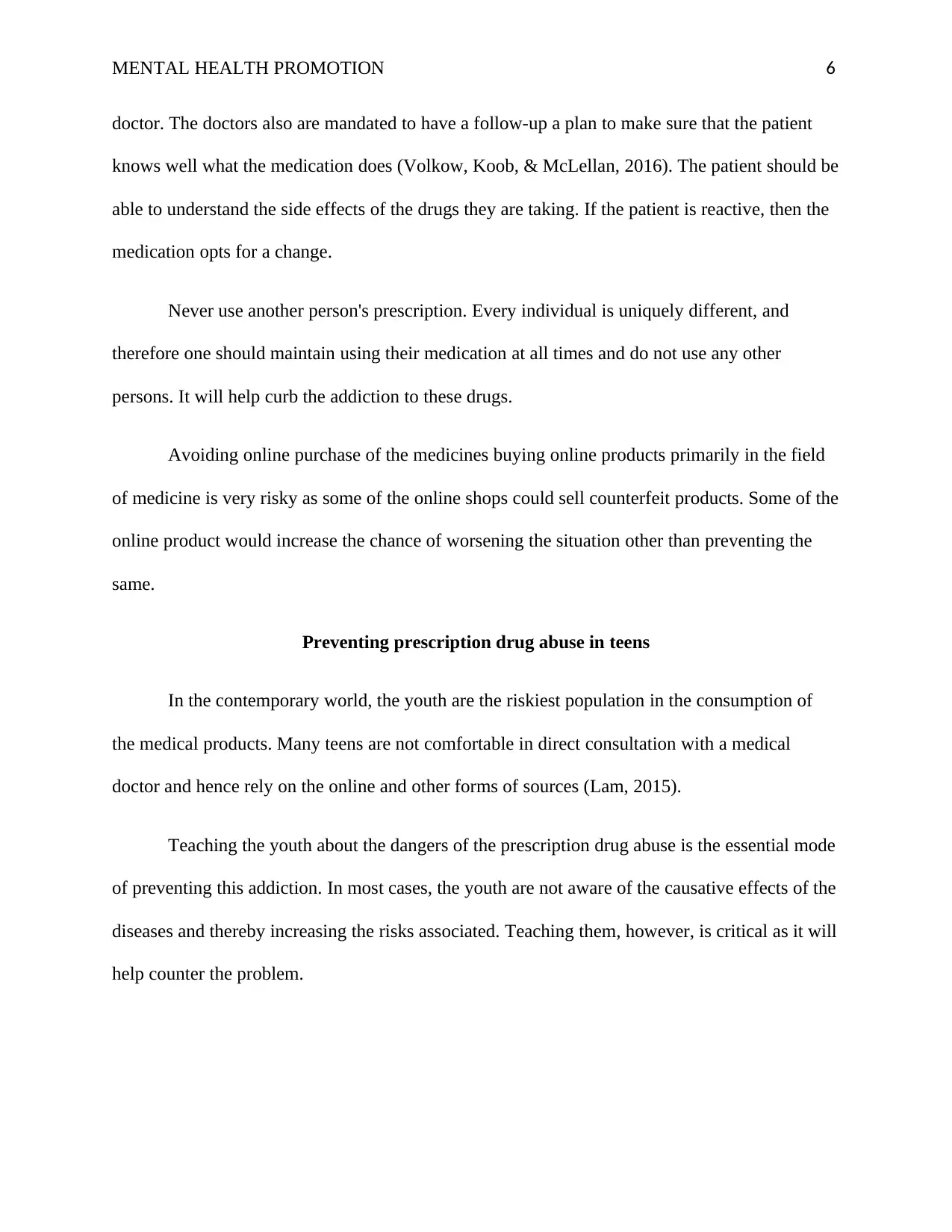
MENTAL HEALTH PROMOTION 6
doctor. The doctors also are mandated to have a follow-up a plan to make sure that the patient
knows well what the medication does (Volkow, Koob, & McLellan, 2016). The patient should be
able to understand the side effects of the drugs they are taking. If the patient is reactive, then the
medication opts for a change.
Never use another person's prescription. Every individual is uniquely different, and
therefore one should maintain using their medication at all times and do not use any other
persons. It will help curb the addiction to these drugs.
Avoiding online purchase of the medicines buying online products primarily in the field
of medicine is very risky as some of the online shops could sell counterfeit products. Some of the
online product would increase the chance of worsening the situation other than preventing the
same.
Preventing prescription drug abuse in teens
In the contemporary world, the youth are the riskiest population in the consumption of
the medical products. Many teens are not comfortable in direct consultation with a medical
doctor and hence rely on the online and other forms of sources (Lam, 2015).
Teaching the youth about the dangers of the prescription drug abuse is the essential mode
of preventing this addiction. In most cases, the youth are not aware of the causative effects of the
diseases and thereby increasing the risks associated. Teaching them, however, is critical as it will
help counter the problem.
doctor. The doctors also are mandated to have a follow-up a plan to make sure that the patient
knows well what the medication does (Volkow, Koob, & McLellan, 2016). The patient should be
able to understand the side effects of the drugs they are taking. If the patient is reactive, then the
medication opts for a change.
Never use another person's prescription. Every individual is uniquely different, and
therefore one should maintain using their medication at all times and do not use any other
persons. It will help curb the addiction to these drugs.
Avoiding online purchase of the medicines buying online products primarily in the field
of medicine is very risky as some of the online shops could sell counterfeit products. Some of the
online product would increase the chance of worsening the situation other than preventing the
same.
Preventing prescription drug abuse in teens
In the contemporary world, the youth are the riskiest population in the consumption of
the medical products. Many teens are not comfortable in direct consultation with a medical
doctor and hence rely on the online and other forms of sources (Lam, 2015).
Teaching the youth about the dangers of the prescription drug abuse is the essential mode
of preventing this addiction. In most cases, the youth are not aware of the causative effects of the
diseases and thereby increasing the risks associated. Teaching them, however, is critical as it will
help counter the problem.
⊘ This is a preview!⊘
Do you want full access?
Subscribe today to unlock all pages.

Trusted by 1+ million students worldwide

MENTAL HEALTH PROMOTION 7
Setting rules, it is essential to understand that setting rules to the youth about the drug
abuse is one of the most critical policies of controlling the addiction. Some of the rules include
that teens should not use another person's medication at any time.
Discuss the dangers of alcohol use. The medical practitioners need to explain to the youth
about the dangers of drug and substance abuse. It would help them increase their mental capacity
on the counters of drug addiction.
Parents should ensure their children are not ordering drugs online (Jones, Christensen, &
Gladden, 2017). Teens could be victims of self-assessment practices which could lead to the poor
and dangerous use of the drugs. Online markets are the shops these children run to and collect
the medicines which make then addicts (Hassamal, et al., 2017).
Appropriate disposals of medications: It is advised to dispose of any medication
appropriately. It would help prevent other people from using drugs that are not appropriate and
effective to their bodies (Clement et al., 2015).
Objectives and goals of the SFF program
Improve the life skills and resilience of the children; Improve parenting for the parents
within the health facility through the provision of services to the parents and creating awareness
for the mental health initiative where the relationship between the mother and the child becomes
the center of attraction to help reduce depression, anxiety, and other stressors; Improve parenting
to an effective and positive one and Improve communication within the family.
Strengthening Families for the Future (SFF) in light of a program created in the late 1980s. It is a
14-week avoidance program for families with kids ages 10 to 28 who are at risk for drug abuse
Setting rules, it is essential to understand that setting rules to the youth about the drug
abuse is one of the most critical policies of controlling the addiction. Some of the rules include
that teens should not use another person's medication at any time.
Discuss the dangers of alcohol use. The medical practitioners need to explain to the youth
about the dangers of drug and substance abuse. It would help them increase their mental capacity
on the counters of drug addiction.
Parents should ensure their children are not ordering drugs online (Jones, Christensen, &
Gladden, 2017). Teens could be victims of self-assessment practices which could lead to the poor
and dangerous use of the drugs. Online markets are the shops these children run to and collect
the medicines which make then addicts (Hassamal, et al., 2017).
Appropriate disposals of medications: It is advised to dispose of any medication
appropriately. It would help prevent other people from using drugs that are not appropriate and
effective to their bodies (Clement et al., 2015).
Objectives and goals of the SFF program
Improve the life skills and resilience of the children; Improve parenting for the parents
within the health facility through the provision of services to the parents and creating awareness
for the mental health initiative where the relationship between the mother and the child becomes
the center of attraction to help reduce depression, anxiety, and other stressors; Improve parenting
to an effective and positive one and Improve communication within the family.
Strengthening Families for the Future (SFF) in light of a program created in the late 1980s. It is a
14-week avoidance program for families with kids ages 10 to 28 who are at risk for drug abuse
Paraphrase This Document
Need a fresh take? Get an instant paraphrase of this document with our AI Paraphraser
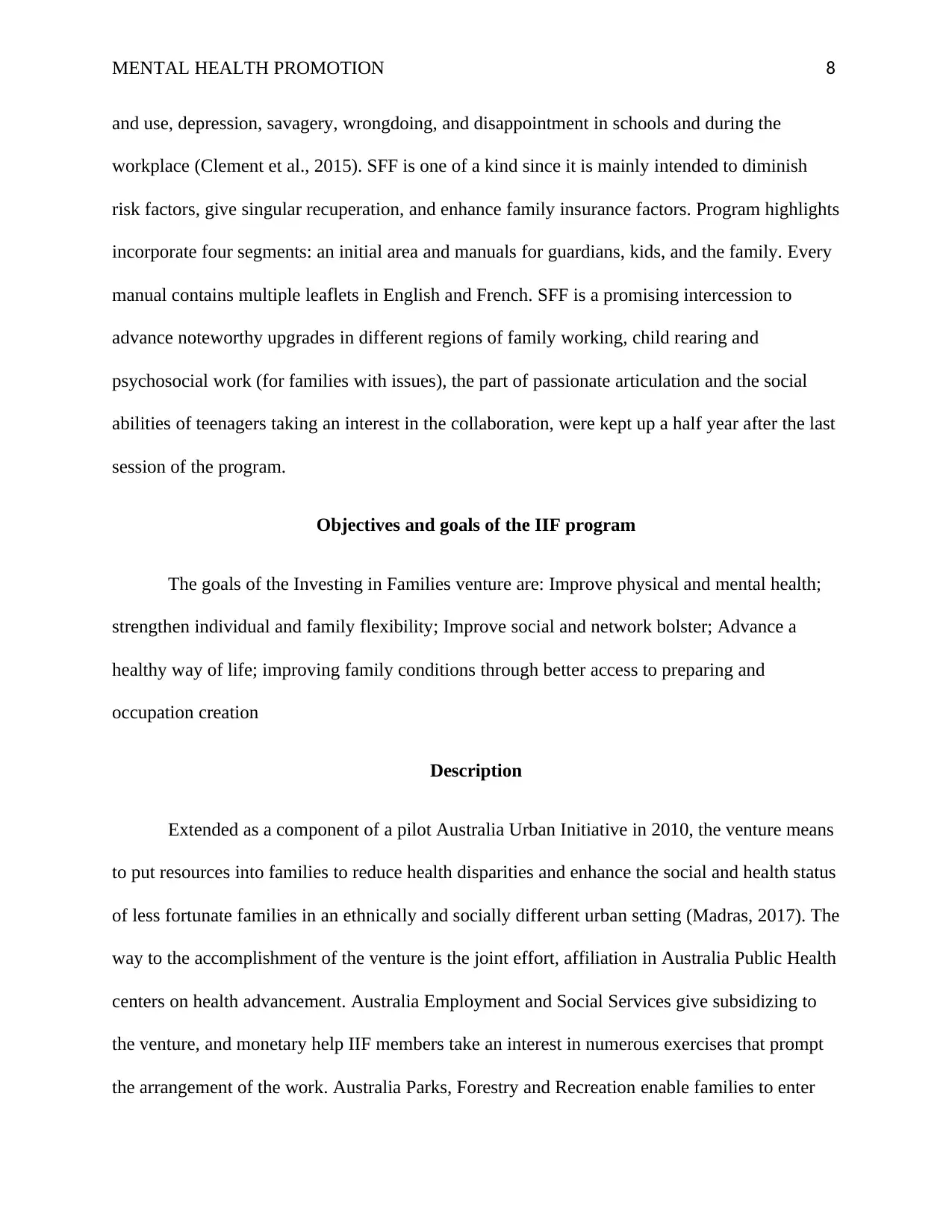
MENTAL HEALTH PROMOTION 8
and use, depression, savagery, wrongdoing, and disappointment in schools and during the
workplace (Clement et al., 2015). SFF is one of a kind since it is mainly intended to diminish
risk factors, give singular recuperation, and enhance family insurance factors. Program highlights
incorporate four segments: an initial area and manuals for guardians, kids, and the family. Every
manual contains multiple leaflets in English and French. SFF is a promising intercession to
advance noteworthy upgrades in different regions of family working, child rearing and
psychosocial work (for families with issues), the part of passionate articulation and the social
abilities of teenagers taking an interest in the collaboration, were kept up a half year after the last
session of the program.
Objectives and goals of the IIF program
The goals of the Investing in Families venture are: Improve physical and mental health;
strengthen individual and family flexibility; Improve social and network bolster; Advance a
healthy way of life; improving family conditions through better access to preparing and
occupation creation
Description
Extended as a component of a pilot Australia Urban Initiative in 2010, the venture means
to put resources into families to reduce health disparities and enhance the social and health status
of less fortunate families in an ethnically and socially different urban setting (Madras, 2017). The
way to the accomplishment of the venture is the joint effort, affiliation in Australia Public Health
centers on health advancement. Australia Employment and Social Services give subsidizing to
the venture, and monetary help IIF members take an interest in numerous exercises that prompt
the arrangement of the work. Australia Parks, Forestry and Recreation enable families to enter
and use, depression, savagery, wrongdoing, and disappointment in schools and during the
workplace (Clement et al., 2015). SFF is one of a kind since it is mainly intended to diminish
risk factors, give singular recuperation, and enhance family insurance factors. Program highlights
incorporate four segments: an initial area and manuals for guardians, kids, and the family. Every
manual contains multiple leaflets in English and French. SFF is a promising intercession to
advance noteworthy upgrades in different regions of family working, child rearing and
psychosocial work (for families with issues), the part of passionate articulation and the social
abilities of teenagers taking an interest in the collaboration, were kept up a half year after the last
session of the program.
Objectives and goals of the IIF program
The goals of the Investing in Families venture are: Improve physical and mental health;
strengthen individual and family flexibility; Improve social and network bolster; Advance a
healthy way of life; improving family conditions through better access to preparing and
occupation creation
Description
Extended as a component of a pilot Australia Urban Initiative in 2010, the venture means
to put resources into families to reduce health disparities and enhance the social and health status
of less fortunate families in an ethnically and socially different urban setting (Madras, 2017). The
way to the accomplishment of the venture is the joint effort, affiliation in Australia Public Health
centers on health advancement. Australia Employment and Social Services give subsidizing to
the venture, and monetary help IIF members take an interest in numerous exercises that prompt
the arrangement of the work. Australia Parks, Forestry and Recreation enable families to enter
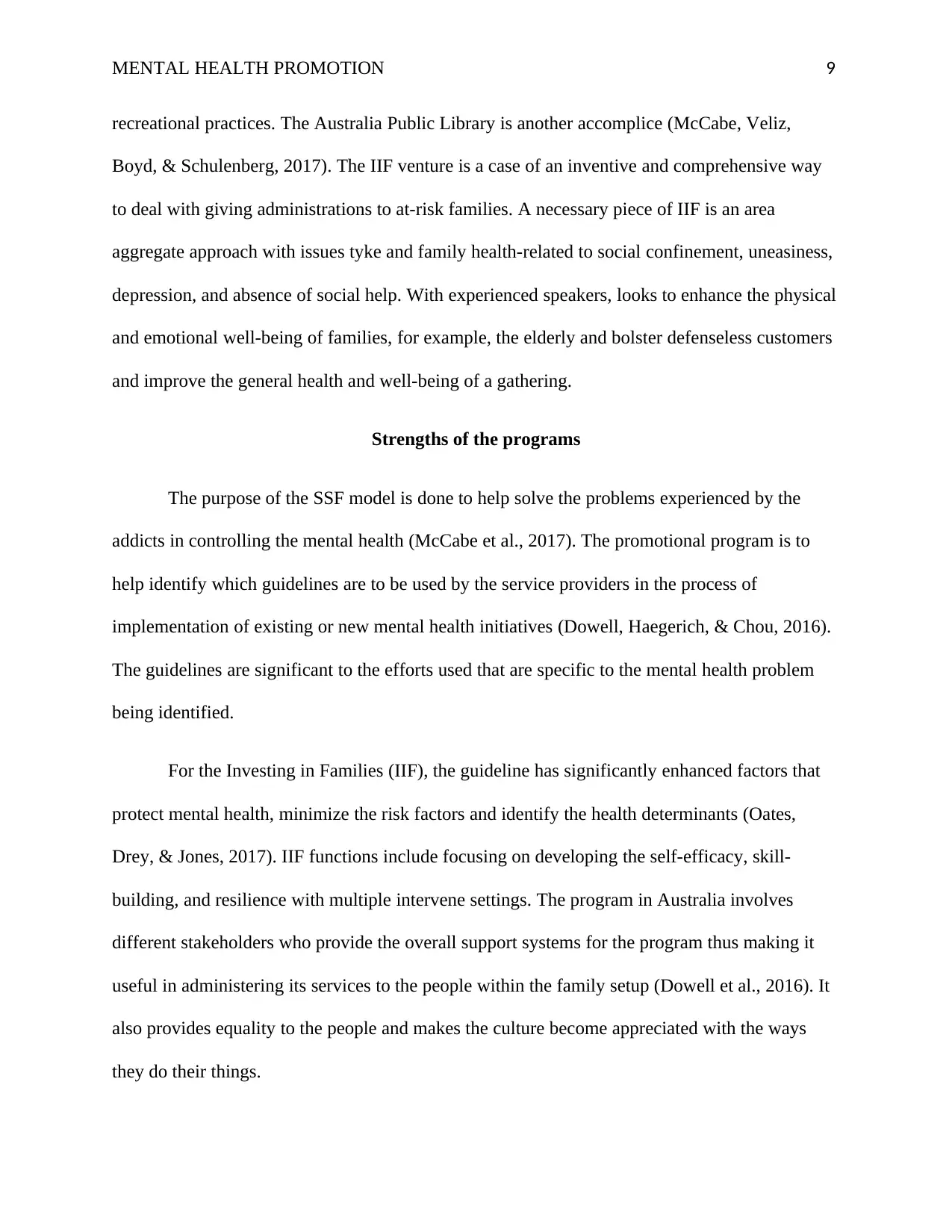
MENTAL HEALTH PROMOTION 9
recreational practices. The Australia Public Library is another accomplice (McCabe, Veliz,
Boyd, & Schulenberg, 2017). The IIF venture is a case of an inventive and comprehensive way
to deal with giving administrations to at-risk families. A necessary piece of IIF is an area
aggregate approach with issues tyke and family health-related to social confinement, uneasiness,
depression, and absence of social help. With experienced speakers, looks to enhance the physical
and emotional well-being of families, for example, the elderly and bolster defenseless customers
and improve the general health and well-being of a gathering.
Strengths of the programs
The purpose of the SSF model is done to help solve the problems experienced by the
addicts in controlling the mental health (McCabe et al., 2017). The promotional program is to
help identify which guidelines are to be used by the service providers in the process of
implementation of existing or new mental health initiatives (Dowell, Haegerich, & Chou, 2016).
The guidelines are significant to the efforts used that are specific to the mental health problem
being identified.
For the Investing in Families (IIF), the guideline has significantly enhanced factors that
protect mental health, minimize the risk factors and identify the health determinants (Oates,
Drey, & Jones, 2017). IIF functions include focusing on developing the self-efficacy, skill-
building, and resilience with multiple intervene settings. The program in Australia involves
different stakeholders who provide the overall support systems for the program thus making it
useful in administering its services to the people within the family setup (Dowell et al., 2016). It
also provides equality to the people and makes the culture become appreciated with the ways
they do their things.
recreational practices. The Australia Public Library is another accomplice (McCabe, Veliz,
Boyd, & Schulenberg, 2017). The IIF venture is a case of an inventive and comprehensive way
to deal with giving administrations to at-risk families. A necessary piece of IIF is an area
aggregate approach with issues tyke and family health-related to social confinement, uneasiness,
depression, and absence of social help. With experienced speakers, looks to enhance the physical
and emotional well-being of families, for example, the elderly and bolster defenseless customers
and improve the general health and well-being of a gathering.
Strengths of the programs
The purpose of the SSF model is done to help solve the problems experienced by the
addicts in controlling the mental health (McCabe et al., 2017). The promotional program is to
help identify which guidelines are to be used by the service providers in the process of
implementation of existing or new mental health initiatives (Dowell, Haegerich, & Chou, 2016).
The guidelines are significant to the efforts used that are specific to the mental health problem
being identified.
For the Investing in Families (IIF), the guideline has significantly enhanced factors that
protect mental health, minimize the risk factors and identify the health determinants (Oates,
Drey, & Jones, 2017). IIF functions include focusing on developing the self-efficacy, skill-
building, and resilience with multiple intervene settings. The program in Australia involves
different stakeholders who provide the overall support systems for the program thus making it
useful in administering its services to the people within the family setup (Dowell et al., 2016). It
also provides equality to the people and makes the culture become appreciated with the ways
they do their things.
⊘ This is a preview!⊘
Do you want full access?
Subscribe today to unlock all pages.

Trusted by 1+ million students worldwide

MENTAL HEALTH PROMOTION
10
Weaknesses
The SSF has a gap because it takes so much time to have the initiatives to be
implemented. Typically, the implementation depends on the previous versions and findings thus
making unsuitable for the new happenings within the mental health handling.
Roles of Nurses in the Help of the Addicted Persons
The nurses have the crucial role to play in the help of the mental health problem. They
make sure that the initiatives are well utilized (Worden, 2018). They keep individual records of
the individuals with the specific condition and then monitor their progress. If they happen to
have other changes, they note down and reports to the relevant authorities for further actions to
be taken.
Nurses cultivate an environment that allows the patients to have peaceful correlations
with each other. It reduces the difference that people have and gives them ample time to handle
the levels of depression and anxiety (Mowbray et al., 2017). In the long run, it becomes the
better way for them to identify what their patients are suffering from and manage their conditions
with ease.
Conclusion
The problem of mental health is becoming a disaster for many individuals. People don’t
realize when they get addicted to a specific substance until the point it worsens, and they can’t do
without it. There are various ways through which the resolution of the problem as mentioned
above but still, there is the need for further conduction of research. Prescription drugs must be
taken when someone is in severe conditions that need the medications prescribed by the doctor.
10
Weaknesses
The SSF has a gap because it takes so much time to have the initiatives to be
implemented. Typically, the implementation depends on the previous versions and findings thus
making unsuitable for the new happenings within the mental health handling.
Roles of Nurses in the Help of the Addicted Persons
The nurses have the crucial role to play in the help of the mental health problem. They
make sure that the initiatives are well utilized (Worden, 2018). They keep individual records of
the individuals with the specific condition and then monitor their progress. If they happen to
have other changes, they note down and reports to the relevant authorities for further actions to
be taken.
Nurses cultivate an environment that allows the patients to have peaceful correlations
with each other. It reduces the difference that people have and gives them ample time to handle
the levels of depression and anxiety (Mowbray et al., 2017). In the long run, it becomes the
better way for them to identify what their patients are suffering from and manage their conditions
with ease.
Conclusion
The problem of mental health is becoming a disaster for many individuals. People don’t
realize when they get addicted to a specific substance until the point it worsens, and they can’t do
without it. There are various ways through which the resolution of the problem as mentioned
above but still, there is the need for further conduction of research. Prescription drugs must be
taken when someone is in severe conditions that need the medications prescribed by the doctor.
Paraphrase This Document
Need a fresh take? Get an instant paraphrase of this document with our AI Paraphraser

MENTAL HEALTH PROMOTION
11
If this is followed, there will be a reduced addiction, and in many cases affecting the mental
health of a person will also be minimized. Therefore, the early realization of the habit is better to
help reduce the risks associated with the treatment plan.
11
If this is followed, there will be a reduced addiction, and in many cases affecting the mental
health of a person will also be minimized. Therefore, the early realization of the habit is better to
help reduce the risks associated with the treatment plan.
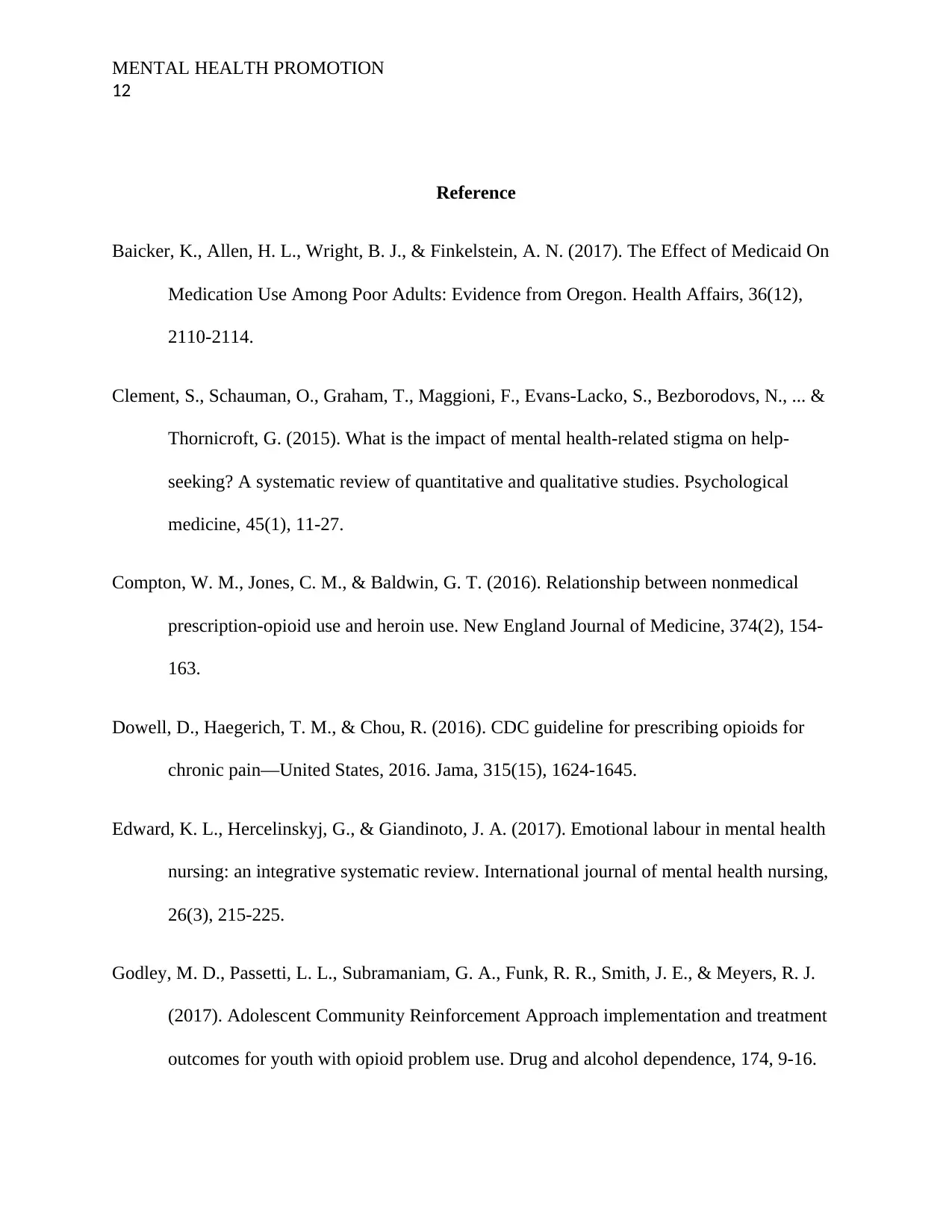
MENTAL HEALTH PROMOTION
12
Reference
Baicker, K., Allen, H. L., Wright, B. J., & Finkelstein, A. N. (2017). The Effect of Medicaid On
Medication Use Among Poor Adults: Evidence from Oregon. Health Affairs, 36(12),
2110-2114.
Clement, S., Schauman, O., Graham, T., Maggioni, F., Evans-Lacko, S., Bezborodovs, N., ... &
Thornicroft, G. (2015). What is the impact of mental health-related stigma on help-
seeking? A systematic review of quantitative and qualitative studies. Psychological
medicine, 45(1), 11-27.
Compton, W. M., Jones, C. M., & Baldwin, G. T. (2016). Relationship between nonmedical
prescription-opioid use and heroin use. New England Journal of Medicine, 374(2), 154-
163.
Dowell, D., Haegerich, T. M., & Chou, R. (2016). CDC guideline for prescribing opioids for
chronic pain—United States, 2016. Jama, 315(15), 1624-1645.
Edward, K. L., Hercelinskyj, G., & Giandinoto, J. A. (2017). Emotional labour in mental health
nursing: an integrative systematic review. International journal of mental health nursing,
26(3), 215-225.
Godley, M. D., Passetti, L. L., Subramaniam, G. A., Funk, R. R., Smith, J. E., & Meyers, R. J.
(2017). Adolescent Community Reinforcement Approach implementation and treatment
outcomes for youth with opioid problem use. Drug and alcohol dependence, 174, 9-16.
12
Reference
Baicker, K., Allen, H. L., Wright, B. J., & Finkelstein, A. N. (2017). The Effect of Medicaid On
Medication Use Among Poor Adults: Evidence from Oregon. Health Affairs, 36(12),
2110-2114.
Clement, S., Schauman, O., Graham, T., Maggioni, F., Evans-Lacko, S., Bezborodovs, N., ... &
Thornicroft, G. (2015). What is the impact of mental health-related stigma on help-
seeking? A systematic review of quantitative and qualitative studies. Psychological
medicine, 45(1), 11-27.
Compton, W. M., Jones, C. M., & Baldwin, G. T. (2016). Relationship between nonmedical
prescription-opioid use and heroin use. New England Journal of Medicine, 374(2), 154-
163.
Dowell, D., Haegerich, T. M., & Chou, R. (2016). CDC guideline for prescribing opioids for
chronic pain—United States, 2016. Jama, 315(15), 1624-1645.
Edward, K. L., Hercelinskyj, G., & Giandinoto, J. A. (2017). Emotional labour in mental health
nursing: an integrative systematic review. International journal of mental health nursing,
26(3), 215-225.
Godley, M. D., Passetti, L. L., Subramaniam, G. A., Funk, R. R., Smith, J. E., & Meyers, R. J.
(2017). Adolescent Community Reinforcement Approach implementation and treatment
outcomes for youth with opioid problem use. Drug and alcohol dependence, 174, 9-16.
⊘ This is a preview!⊘
Do you want full access?
Subscribe today to unlock all pages.

Trusted by 1+ million students worldwide
1 out of 14
Related Documents
Your All-in-One AI-Powered Toolkit for Academic Success.
+13062052269
info@desklib.com
Available 24*7 on WhatsApp / Email
![[object Object]](/_next/static/media/star-bottom.7253800d.svg)
Unlock your academic potential
Copyright © 2020–2026 A2Z Services. All Rights Reserved. Developed and managed by ZUCOL.





